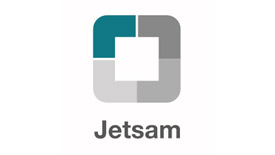Most new users of LiquidPlanner are driven to the enterprise-level project management solution by a sense of impending crisis.
They feel like they’ve reached a point in their work lives—and workflows—where there are just too many projects, too many resources, and too many constraints on time and resources to manage effectively with spreadsheets or a cobbled together system of weekly meetings and enforced reporting.
Most new users of LiquidPlanner are trying to impose order on burgeoning chaos of growth and opportunity.
However, Germany’s Jetsam Service Management, a team of sales service experts that provides after-market support to big consumer electronics firms like Toshiba, is different in this regard. Instead of using LiquidPlanner to manage an overwhelming multitude of typically sized projects, the firm specifically adopted the PM solution in August 2018 to thoroughly analyze the risks and expense of just one project, albeit a project big enough to dramatically affect Jetsam’s operations and profits.
“In 2018, my IT team was considering the implementation of a new ERP [enterprise resource planning] system for spare parts handling in Europe and the Middle East,” explains Roland Schaeffer, Jetsam’s service IT engineer. “Since this is a big part of our business and would affect operations dramatically during implementation, we really needed good predictions of just how long the implementation would take and how many hours of staff time would be involved.”
Making these predictions with confident authority was no small task; Schaeffer was trying to predictively manage several external service providers, five in-house developers, and three in-house project managers, all over a long project lifecycle, while also managing complex time constraints including holidays, leave, and the pressures of annual business cycles. When this work was done, he also needed a good way to present the results and conclusion to Toshiba’s European management team.
In other words, LiquidPlanner wasn’t being used primarily as a project management tool; rather, it was being used as a project analysis tool, and its success in this role is a testament to the solution’s versatility and power, and also to Schaeffer’s farsighted and flexible thinking. For both reasons, this implementation of LiquidPlanner was highly successful for Jetsam and Toshiba when making a final decision about a really big investment in ERP software.
That final decision may surprise you.
Why LiquidPlanner?
“When it comes to repair or replacement of Toshiba products in our region and spare parts management, Toshiba’s Service IT system is managed by Jetsam,” Schaeffer says. “That’s why it was so important to evaluate this proposal carefully before committing.”
Before this initiative, project management at Jetsam had been relatively casual, depending mainly on hardworking spreadsheets and some use of an open-source project-management and tracking tool. Schaeffer knew that he needed more powerful resource-planning capabilities for the analysis task at hand, and Internet research suggested that LiquidPlanner’s predictive scheduling engine would be perfect. In fact, it looked so good that Schaeffer decided to “learn by doing” and ordered sufficient seats for two teams in separate locations to get started.
“We had support from our upper management and from Toshiba,” Schaeffer explains. “They knew we didn’t really have the right tools to work with, and we did sufficient research to give a good presentation, so we got the go ahead.”
The initial project set up was accomplished without special training, mainly by being persistent. “Our biggest problem was that the ERP proposal was so big at first that we had trouble being sure we were accounting for all factors,” says Schaeffer, “but finally, we decided to break up the proposal into several smaller projects and analyze them individually.”
Schaeffer knew going in that LiquidPlanner’s predictive scheduling engine, which updates project timelines in real-time based on user inputs, would be important for this project analysis—basically, once most of the project inputs (in terms of resource allocations, schedule constraints, etc.) are entered, the PSE allows managers to “tinker” with different prioritizations and allocations and immediately see how adjustments affect timelines. As project managers make adjustments and receive immediate feedback, they ultimately develop an informed intuition about the most productive use of enterprise assets.
Unexpectedly, two additional features also turned out to be surprisingly essential when analyzing this large and risky ERP implementation.
The first was LiquidPlanner’s collaboration tools. “We were surprised by how much time and effort was saved by our IT team when using LiquidPlanner’s communication tools,” Schaeffer says. “We were used to scheduling monthly meetings, of several hours each, to set project priorities and to define and assign tasks. With LiquidPlanner installed, the provided project communication tools were effective enough to nearly eliminate all the internal meetings on our side.”
For communicating with upper management and external stakeholders (primarily Toshiba executives), LiquidPlanner’s visual reporting solutions were extremely helpful and also had an effect on meetings. “In Gantt diagrams and in customized dashboards, we were able to clearly convey our findings to all stakeholders,” Schaeffer explains. “That didn’t eliminate meetings outside our group, but it did reduce the quantity and length of these types of meetings because the reports and dashboards were so effective at getting across the essential results of our analysis.”
The Road Not Taken
The results of Jetsam’s thorough analysis of the proposed ERP project were admirably clear. “It was much too big and expensive for us,” says Schaeffer, simply. “Given the risk, and the time and effort expended over at least half a year, the possible gains just weren’t compelling enough to proceed.”
Deciding not to take on a project sounds like a failure of sorts or at least a big letdown, but Schaeffer doesn’t see it that way. “This was a big success,” he says, emphatically. “Without the high-quality, predictive information we were able to generate with LiquidPlanner, we might easily have spent most of a year, and many euros, on a project that wasn’t worth it. Confidently avoiding that outcome was a big win for us.”
Even when making the decision to pass, there were important gains. “We were able to identify parts of the proposal—maybe 10 to 15 percent of the original plan—that could be realized effectively and smoothly. For the rest, the work we did on this helped point us to creative solutions that we might not have found otherwise.”
You could say, when it comes to planning projects, LiquidPlanner is the best choice—even when the choice made is to not do the project.


